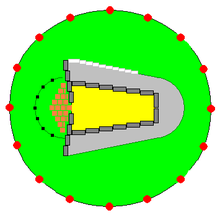Wedge Tomb



Wedge Tomb ( German "Keilgrab" , formerly also called wedge-shaped gallery grave ) is a double-walled, aisle-free, mostly undivided megalithic complex from the late Neolithic and early Bronze Age and, along with Court Tombs , Portal Tombs and Passage Tombs, is typical of the western half of Ireland .
Occurrence
There are 569 known (preserved) Wedge Tombs in Ireland . They occur mainly in Munster (about 50%) and the western half of the island, especially in the counties of Cork and Clare , where about 120 are known in the Burren alone . In Leinster there are 15. In County Waterford in the southeast of the island there are only two specimens ( Carrickavrantry and Munmahoge ). Some are in western Northern Ireland , not in Counties Armagh and Down in the east.
In the rest of the UK , there are around 50 in the Isles of Scilly and 20 in Cornwall and Wales ( Parc-y-Cromlech at Fishguard in Pembrokeshire ).
construction
Wedge Tombs are mainly made of vertically positioned limestone slabs and are characterized by a gallery of aligned lateral supporting stones, the height of which decreases from the western to the eastern end. The gallery is sometimes rectangular in plan, but mostly wedge-shaped with an end plate and rarely as high as a man. Slabs that lie on the supporting stones cover the interior. The buildings were covered by a cairn made of stones the size of a head, which was framed by an outer wall that ran parallel to the wall of the chamber, but was mostly lower and that was often not preserved. The side walls were made up of double rows of stones (three in some cases) called double or triple walls. The as yet little investigated systems have no parallels anywhere in the continental megalithic area and are regionally designed in Ireland. They are divided into a northern and a southern type, with a smooth transition. The wedge grave may have a low facade (like Island in County Cork) at the entrance . Usually wedge tombs are oriented west-east. The access, which is mostly in the east, is usually closed by a single large stone.
The investments of Baurnadomeeny in County Tipperary with preserved curb circle Labbacallee wedge tomb in County Cork, the largest plant of this type, loughmacrory III in County Tyrone and Boviel in County Londonderry small antechambers were found. Systems such as Ballyedmonduff in County Dublin , Loughash and Cashelbane in County Tyrone have antechamber and end chambers, which are otherwise found in other types of systems in Brittany . Some wedge tombs are very short. Reananiree in County Cork is only a little over three feet long. Others are framed by a stone circle or have a paved forecourt and low stone pillars in front of the entrance (see picture). In Knockoneill in County Londonderry, it could be a subsequently converted into a Wedge Tomb Court Tomb act.
See also
literature
- Elizabeth Shee Twohig: Irish Megalithic tombs . Shire, Princes Risborough 1990, ISBN 0-7478-0094-4 ( Shire archeology 63).
- Jürgen E. Walkowitz: The megalithic syndrome. European cult sites of the Stone Age (= contributions to the prehistory and early history of Central Europe. Vol. 36). Beier & Beran, Langenweißbach 2003, ISBN 3-930036-70-3 .
- Michael J. O'Kelly: A wedge-shaped gallery grave at Baurnadomeeny, C. Tipperary . In: Journal of the Cork Historical and Archaeological Society . 65, 2, 1960, ISSN 0010-8731 , pp. 85-115.
Web links
- Wedge-tombs: photographs by Anthony Weir ( Memento from June 29, 2009 in the Internet Archive ) - picture collection (last accessed on December 5, 2012)
- megalithomania ( Memento from February 16, 2006 in the Internet Archive ) - List of attachments (last accessed on December 5, 2012)
- Wedge Tombs engl.
